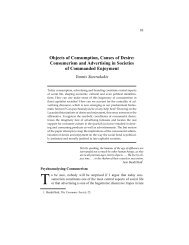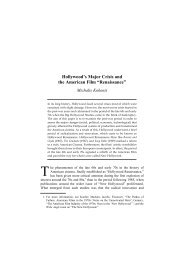19 International Symposium on Theoretical and Applied Linguistics ...
19 International Symposium on Theoretical and Applied Linguistics ...
19 International Symposium on Theoretical and Applied Linguistics ...
Create successful ePaper yourself
Turn your PDF publications into a flip-book with our unique Google optimized e-Paper software.
G E N E R A L S E S S I O N<br />
case before providing a unified theoretical treatment of c<strong>on</strong>jugati<strong>on</strong>al classes. I argue that the<br />
specificati<strong>on</strong> of theme vowels -the markers of class- can be seen in terms of abstract, binary features.<br />
Special attenti<strong>on</strong> is paid <strong>on</strong> to the exact properties <strong>and</strong> functi<strong>on</strong> of these features. This is shown to<br />
explain directly questi<strong>on</strong>s (a-c), whereas I move <strong>on</strong>to the predicti<strong>on</strong>s this theory makes for (d-e).<br />
C<strong>on</strong>sequences: In the final secti<strong>on</strong> of the paper, I compare the answers to the aforementi<strong>on</strong>ed<br />
questi<strong>on</strong>s given in word-<strong>and</strong>-paradigm models (cf. Matthews <str<strong>on</strong>g>19</str<strong>on</strong>g>91) <strong>and</strong> Carstairs’ (<str<strong>on</strong>g>19</str<strong>on</strong>g>83) morphemebased<br />
approach <strong>and</strong> Distributed Morphology, as sketched here, focusing <strong>on</strong> ec<strong>on</strong>omy c<strong>on</strong>siderati<strong>on</strong>s<br />
<strong>and</strong> the predicti<strong>on</strong>s made regarding the number of the possible c<strong>on</strong>jugati<strong>on</strong>al classes within a system.<br />
Doubling the double object clitic cluster: a Northwestern Greek Dialect<br />
1 Alex<strong>and</strong>ra Galani & 2 George Tsoulas<br />
1&2 University of York<br />
1 ag153@york.ac.uk, 2 gt3@york.ac.uk<br />
Clitics in St<strong>and</strong>ard Modern Greek have been extensively discussed in the literature, both in both m<strong>on</strong>o<br />
transitive <strong>and</strong> ditransitive c<strong>on</strong>structi<strong>on</strong>s (Anagnostopoulou <str<strong>on</strong>g>19</str<strong>on</strong>g>94, Philippaki-Warburt<strong>on</strong> <strong>and</strong><br />
Spyropoulos <str<strong>on</strong>g>19</str<strong>on</strong>g>98, Joseph <str<strong>on</strong>g>19</str<strong>on</strong>g>88, Alexiadou <strong>and</strong> Anagnostopoulou 2000, Philippaki-Warburt<strong>on</strong>, et al<br />
2004, <strong>and</strong> references therein). In ditransitive cases, clitics precede the finite verb in the order dativeaccusative<br />
<strong>on</strong>ly.<br />
(1) a. Tis to ipa.<br />
Her-cl it-cl told-1SG.Pst<br />
I told her<br />
b. *To tis ipa.<br />
It-cl her-cl told-1SG.PST<br />
I told her<br />
Terzi (<str<strong>on</strong>g>19</str<strong>on</strong>g>99) investigated double object clitics in imperatives in St<strong>and</strong>ard Modern Greek <strong>and</strong> Cypriot<br />
Greek. In such c<strong>on</strong>structi<strong>on</strong>s, clitics follow imperatives in either the dative-accusative or the reverse<br />
order.<br />
(2) a. Pite to mu<br />
Say-2PL it-cl me-cl<br />
Say it to me<br />
b. Pite mu to<br />
Say-2PL me-cl it-cl<br />
Say it to me<br />
In this paper we describe certain patterns of multiple clitic occurrence in imperatives in northwestern<br />
Greek dialects. The basic pattern c<strong>on</strong>sists of the repetiti<strong>on</strong> of <strong>on</strong>e of the two clitics, in a way as to end<br />
up with a sequence of three clitics, either in the accusative-dative-accusative order or in the dativeaccusative-dative<br />
<strong>on</strong>e.<br />
(3) a. Pite to mu to<br />
Say-2PL it-cl me-cl it-cl<br />
Say it to me<br />
b. Pite mu to mu<br />
Say-2PL me-cl it-cl me-cl<br />
Say it to me<br />
The analysis suggested here takes this pattern of multiple occurrence of clitics to be an argument in<br />
favour of the existence of copies in the syntactic derivati<strong>on</strong>. We argue that cliticisati<strong>on</strong> involves<br />
movement of the clitic <strong>and</strong> adjuncti<strong>on</strong> to the IP level (we assume a bare phrase structure model<br />
whereby clitics are characterised as both maximal <strong>and</strong> minimal projecti<strong>on</strong>s. Crucially though we argue<br />
that in these dialects more than <strong>on</strong>e copy may be spelled out. This explains the fact that the order of<br />
clitics cannot be disturbed but raises important theoretical issues regarding linearisati<strong>on</strong> <strong>and</strong> spell out.<br />
We propose an analysis al<strong>on</strong>g the lines of Nunes (2004) observing that the duplicati<strong>on</strong> is <strong>on</strong>ly possible<br />
<strong>on</strong>ly with enclisis. We suggest that the complex V+CL undergoes morphological restructuring <strong>and</strong> as a<br />
result the lowest copies are exempted from deleti<strong>on</strong> (n<strong>on</strong> pr<strong>on</strong>unciati<strong>on</strong>). The paper c<strong>on</strong>cludes with a<br />
c<strong>on</strong>siderati<strong>on</strong> of the c<strong>on</strong>sequences of this approach for linearisati<strong>on</strong>.<br />
<str<strong>on</strong>g>19</str<strong>on</strong>g> th ISTAL 15






